Airavatesvara Temple: Discover Serenity And The Spiritual Essence
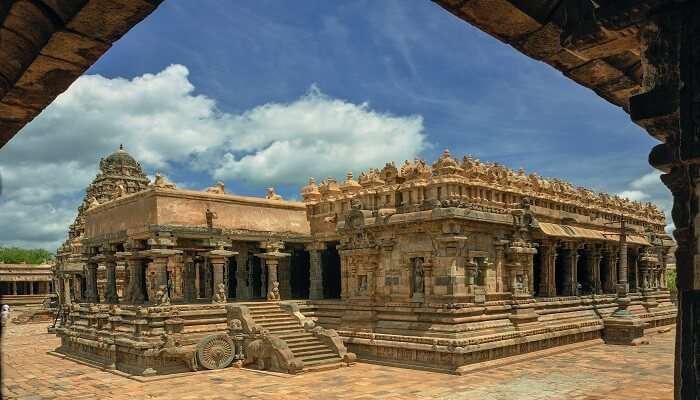
An 80ft structure resembling a chariot, a set of 108 intricately carved pillars and more than 4000 3D sculptures still intact to bewilder you. These may sound like the elements of an indivisible trivia. But link them to the Airavatesvara Temple, and you shall start observing relevance. Daring to surpass the bounds of time and imagination, this temple is not just another Chola-monument but a masterpiece worthy of its UNESCO Heritage Stature.
Travel Guide to Airavatesvara Temple – A Historical Odyssey Beyond the Walls
Built-in the 12th Century by Chola Emperor Rajaraja, the temple bears witness to the craftsmanship and artisans of a bygone era. Dive into the world of ancient Indian Heritage and reveal insights into this magical monument, uncovering the spiritual truths and enduring architectural brilliance.
Must Read: Ayutthaya Temples
Airavatesvara Temple history
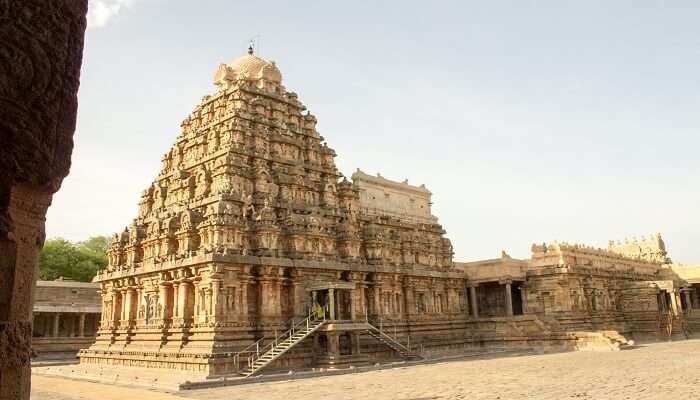
The Airavatesvara Temple is stunning, offering a profound connection to the past with glimpses into the world of our ancestors. The name “Airavat” comes “rom a majestic white elephant linked with Lord Indra (the god of weather as per Hindu Mythology). Legend has it that the elephant was cursed by the short-tempered Sage Durvasa for disrespecting him. The elephant lost all its colour and turned white.
To regain his true shade of skin, Airavat prayed to Lord Shiva, one of the trinity. Lord Shiva asked him to pledge and dip in the sacred pond at this temple, which made him regain his colour again and lift the curse. It is believed that this story led to naming this temple as Airavatesvara Temple. To date, the stories can still be found scripted on the walls of this ancient temple.
The Awe-Inspiring Wonders of Airavatesvara Temple
1. Part of the “Great Living Chola Temples”

Airavatesvara is one of the three main temples built in the Chola Period, standing aside from the Brihadeeswara Temple at Thanjavur and the Gangaikondacholeeswaram Temple at Gangaikonda Cholapuram. The noble trio is also famously called “The Great Living Chola Temples”. The majority of the artwork is detailed in Dravidian architectural style. Interestingly, the entire Airavatesvara Temple is built in the form of a chariot. The rich carvings narrate stories from ancient Indian Puranas.
All three temples are part of the UNESCO World Heritage under the sites designated for the Chola Dynasty of Hindu Temples. The first temple to be added to the list was the one at Thanjavur in 1987. The other two were added in 2004.
Suggested Read: Temples In India
2. Key Architectural Aspects
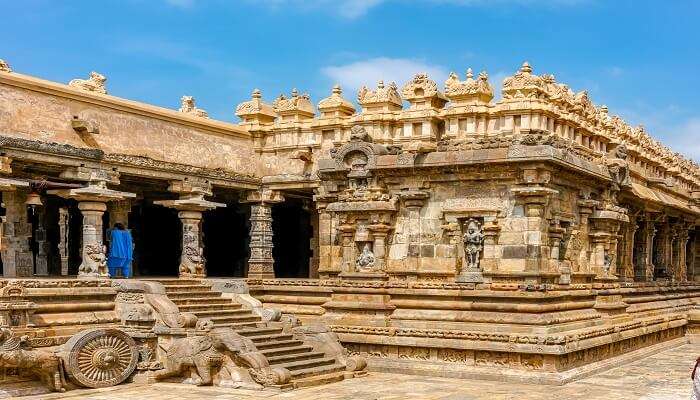
The temple boasts a square plan layout, showcasing impeccable symmetry and accurate geometric patterns. The inner courtyard, still surviving, spans six stacked squares and measures 107 metres by 70 metres in area. Nandi Mandapa and Stambha are other key features, established just outside the main courtyard area. Both of these are aligned accurately per the temple stem axis.
Moving on, you can witness the chariot-shaped Agra-Mandapam. It features hundreds of intricately carved wall sections and a Nandi sculpture atop. The temple’s sanctum boasts a 12-metre-sided square with heavy walls supporting the towering Vimana Superstructure, reaching a height of 24 metres. What’s mWhat’snlike traditional temples, the circumambulation path revolving around the sanctum is situated outside the courtyard. This offers a way of positionally viewing and experiencing it during rituals and worship.
The Grand Maha-mandapa and the Agra-Mandapa echoing architectural motifs, the likes of which one can find in Konark Sun and Chidambaram Temple, are some of the other key aspects of Airavatesvara Temple.
3. Yamatheertham – Sacred Tank
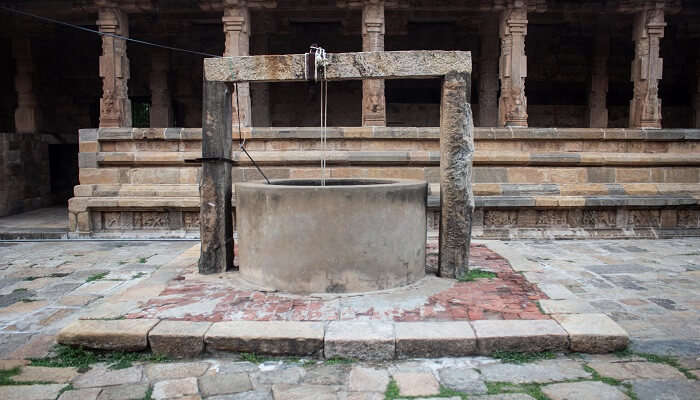
Yamatheertham is another important hotspot for tourists at the Airavatesvara Temple. Just like every other spot, this also has a story associated with it. It is believed that the Lord Yama (God of death) was cursed by a sage, causing him to feel a burning sensation all over his body. He found solace in The Airavatesvara Temple, praying to Lord Shiva to eliminate the curse. He was asked to take a dip in a sacred temple tank, which came to be known as Yamatheertham. Travellers pray to their deities here and make wishes.
Suggested Read: Temples in Jalandhar
4. Temple Inscriptions
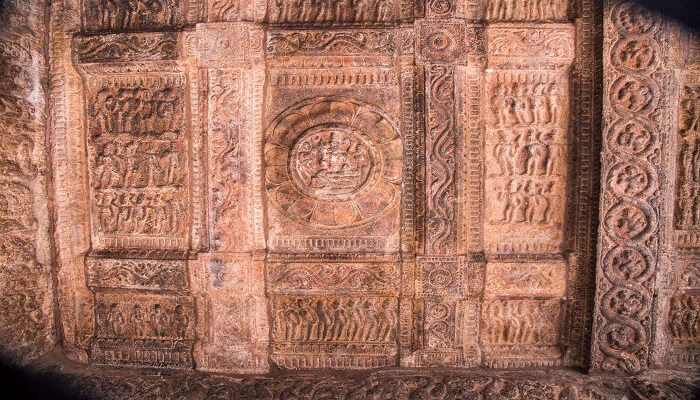
Most travel guides list the structures and constructional facets of the temple. However, the real-life inscriptions at Airavatesvara Temple dating back centuries are even more captivating. They actually do the trick, taking you back to ancient, culture-rich times.
Among these, an important one reveals the temple renovation by Kulottunga Chola III. In the Varandah, there is a canvas that devoutly reveres Saivism, where 108 sections of inscriptions can be found. These offer details about the 63 Saivacharaya from the venerable saints of an old era.
Exploring further into the roots of the sanctum, you will find carved sculptures depicting various goddesses, such as Cauvery, Ganges, Godavari, Narmada, and Yamuna. The inscription also depicts the 108 Devara Athuvars.
Some inscriptions showcase the cultural exchange throughout Indian history. These commemorate Emperor Rajadhiraja Chola I with his divine image from the ancient city of Kalyani. Furthermore, the resplendent forms of Agni Deva (God of fire), Durga Devi (God of valour) and the guardians who watch over the temple leave an incredible mark on the hallowed walls of the temple.
5. The Musical Steps
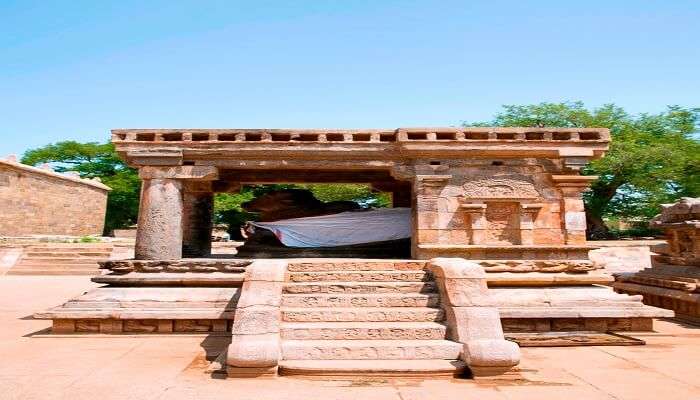
like the origin of language through Sanskrit, Indian culture also led to the fascinating inception of musical chords. You can experience it all at the musical steps of Airavatesvara Temple. Often called “singing steps”, these are an ornately curved flight of seven steps, leading to a spot called “Balipeetham”, the sacrificial altar. The seven steps represent the seven musical notes based on which, every harmony in the world has been created to date.
Well, if you think this is fascinating, there’s more. When you walk on these steps or tap them, you can actually hear the stone beneath producing the melodious notes or “Swaras” of music.
Suggested Read: Hindu Temples in Rajasthan
6. Multi-dimensional sculptures
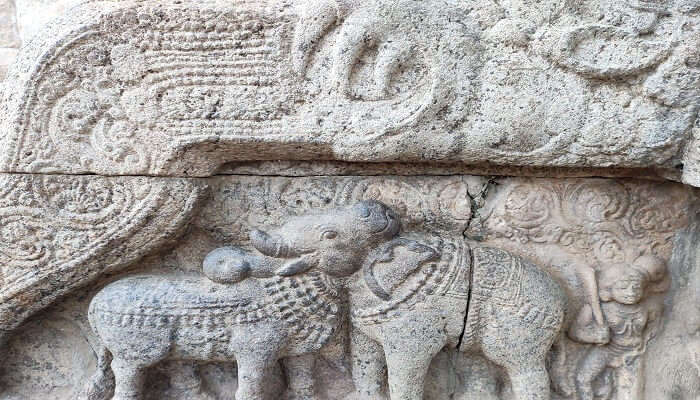
Who would have thought creating illusions would be possible nearly a thousand years ago? Well, the Cholas proved us wrong. The famous multi-dimensional sculpture depicting the head of an elephant from one side and that of a bull from another is not just captivating, but enigmatic. It makes us wonder about the level of innovation and creativity poured into these structures. Talking of sculptures, each body reflects distinct animals while the head represents both, creating an illusion. You could see a bull or an elephant depending on your viewing angle. Now that’s pthat’scient magic!
7. Micro-sculptures and Micro-paintings
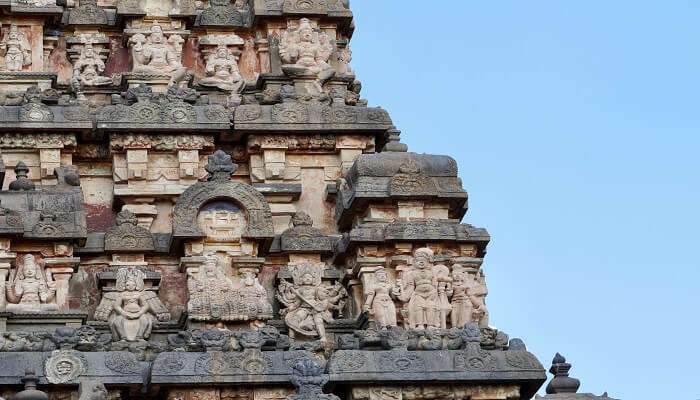
Let’s take a deep breath and then, well, be ready to get bewildered again, courtesy of the micro cravings in every corner of the Airavatesvara Temple. Giving a realistic vision to mini-sculpturing and miniature cravings, the temple reveals intricate and detailed Dravian Vinama. But wait, these are not giant cravings we are talking about. All of these are crafted within an inch. Yes, an inch! It’s astonishing to think how it was done by artisans who were devoid of modern aids like magnifying lenses, complex carving tools, lights to focus and probably specific tools.
Suggested Read: Famous Temples in North India
Airavatesvara Temple Timings
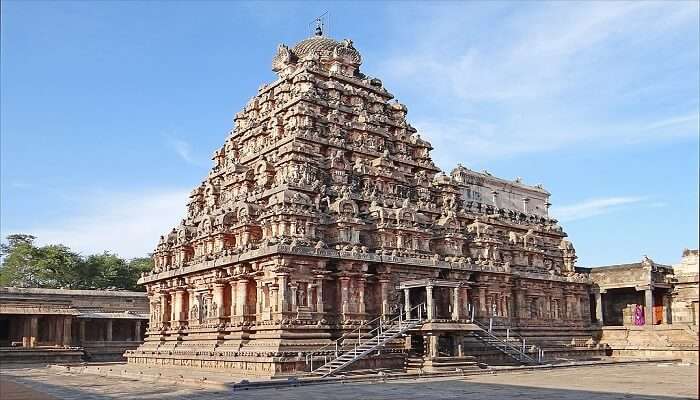
The temple remains open every day. The visiting hours are divided into two sessions, the first being 8 AM to 12 PM and the second from 4 PM to 8 PM as per IST.
So, what Airavatesvara Temple timings are best suited for you?
Travel enthusiasts suggest coming here twice: first, in the morning, when the honey-shaded granite begins to dominate the white-dawned sunshine.
And second, in the evening, when the sculptures embrace the hues of orange, red, and yellow. These are the ideal times to witness the crowning glory of this Chola Temple.
Airavatesvara Temple Location

The temple is located in Tamil Nadu. Now, it may become tough to come out of the architectural sanctuaries of Airavatesvara Temple, still envisioned in the mind. If you get that feeling of being held in the past, it’s totally relatable. But let’s dwell on and realise the importance of such marvels that reflect our ancient culture and history today.
The Airavatesvara Temple is not merely a structure of stone and mortar. It’s a timeless testament to the devotion of our ancient civilisations. It’s the epitome of Chola’s greatness. And most importantly, it’s a living reminder that our ancestors were, in a way, more creative, artistic and devoted to our Gods.
Further Read: Temples In South India
Hope you enjoyed reading this Airavatesvara Temple travel guide. Yet, the words may not do justice to this temple’stemple’sur. It’s a pIt’s that needs to be seen and experienced, deserving all your attention. So plan your trip to Tamil Nadu and explore some of India’s India’schanting and beautiful temples.
Disclaimer: For our editorial codes of conduct and copyright disclaimer, please click here.
Cover Image Source: Shutterstock
Frequently Asked Questions About Airavatesvara Temple
What is the Airavatesvara Temple location?
The temple is located in Kumbakonam of Thanjavur District. Thanjavur is an important division in the South Indian State of Tamil Nadu.
What are the few amazing facts about Airavatesvara Temple?
The temple is more than 1000 years old and is still intact in its ancient form. There are thousands of sculptures here. The musical steps in the temple echo hymns of notes when we walk on them.
What is the main feature of Airavatesvara Temple?
The main structure is home to a 24-metre-high Vimana and a stone image of Lord Shiva, which is the main feature of this temple.
When was the Airavatesvara Temple Built?
The temple was built in the 12th Century by Rajaraja Chola II of the Chola dynasty.
Is Airavatesvara temple a UNESCO Heritage site?
Yes, the Airavatesvara Temple is a declared part of a UNESCO World Heritage site, signifying its importance in maintaining historical culture worldwide
People Also Read:
Temples in TamilNadu Must-visit Buddhist Temples in Sri Lanka Meenakshi Temple Guide

Experience the world through captivating stories of adventure and travel. As a senior content writer, I bring my passion for exploration to life, crafting tales that take you on a journey. With my words, you’ll feel the thrill of discovery and the joy of experiencing new cultures. Let me turn your imagination into a reality with stories that inspire you to explore and embrace the world.











